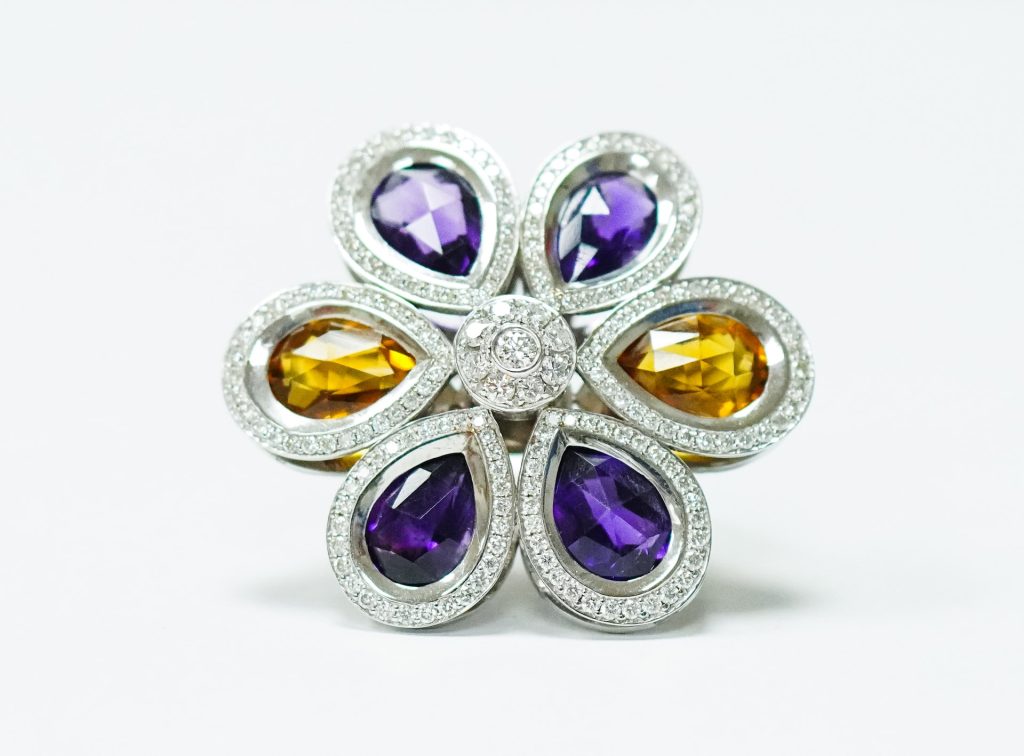Gemstones have been around since ancient times, and their popularity is only increasing. According to a 2022 Future Market Insights report, the gemstone market value is estimated at around $30,779.1 million.
Aside from being one of the most popular gifts women love, gemstones are known to be helpful in various industrial and commercial applications. By understanding the value, rarity, and types of gems, you can make an informed decision the next time you’re in the market for one.
What are Precious Gemstones?
Otherwise called fine gemstones or simply gems or jewels, precious gemstones are minerals mined for various purposes. In many cases, these minerals are cut and polished to adorn different jewelry types. But they may not be suitable for typical chains as used in permanent jewelry pieces or traditional baubles.
All gemstones have some degree of rarity, but a traditional distinction in the jewelry industry has been made between precious and semi-precious stones. This distinction follows principles of archaeology and durability, with a few exceptions.
However, in the last few decades, there has been a gradual shift in this perspective. Jewelers are now considering many gemstones equally valuable, regardless of their classification. That’s why it’s essential to focus on a stone’s quality, color, and overall desirability when making a purchase.
How Do Gems Differ from Rocks and Minerals?

Different stones have unique properties that make them appealing for various reasons. The terms “rock” and “mineral” are often used interchangeably for gems, but they have different meanings.
A rock is a natural material that consists of two or more minerals. They are treated as a single entity and are often found in the Earth’s crust. Some examples include lapis lazuli, quartz and turquoise.
On the other hand, minerals are inorganic substances that have a specific chemical composition. They occur naturally and have a crystalline structure. Diamonds, sapphires, and emeralds are all minerals.
Gemstones are minerals that have been cut and polished to create a beautiful, lustrous surface. They’re often used in jewelry but can also be collectible for their aesthetic value.
How are Precious Stones Formed?
Many gemstones form from hot fluids circulating through cracks or weaknesses in rocks—these fluids deposit minerals on the rock, which gradually hardens and crystallizes over time. But naturally found, precious stones are rarely used in their raw form. Instead, they are cut and polished to enhance their natural beauty.
There are two main methods used to cut and polish precious stones. The Cabochon method involves polishing a stone into a convex shape with a flat back. You can often find Cabochon gemstones in pendants, earrings, and rings.
The Facet method is more famous for transparent gems. It involves polishing a stone into a shape with dozens of small, flat surfaces. It shows the optical properties of the stone to enhance reflected light, which makes the stone sparkle. You’ll see Faceted gems in many types of jewelry, including bracelets, necklaces, and engagement rings.
Other ways of shaping and polishing gemstones include carving, tumbling, and inlay work. However, these methods are less common.
Which Gemstone has the Most Value?

Oppenheimer Blue, or the Blue Diamond, is the world’s most expensive gemstone. It was sold at auction for $57.5 million in 2016, making it worth approximately $3.93 million per carat.
This incredible price is due to the diamond’s unique color, size, and provenance. The Oppenheimer Blue is a Vivid Blue diamond weighing 14.62 carats. It was cut from the stone known as “The Blue,” discovered in the Premier Mine in South Africa in 2014.
What’s a Colored Gemstone?
A colored gemstone is a stone that is not a diamond, with the exception of colored diamonds. The GIA classifies these colored stones as fancy color diamonds. Other than that, all the different colored gems are not diamonds.
Colored gemstones are available in various colors, including blue, green, orange, pink, red, purple, and yellow. Most colored gems form in the Earth’s mantle, the layer below the crust. And through volcanic activity, these stones get brought to the surface.
Some gems are treated to release color. The stones are heated, irradiated, or altered with chemicals to improve their color.
What’s the Most Popular Colored Gemstone?
One of the most famous colored gemstones is rose quartz. It has a soft, pink color and is often used in jewelry or as a decorative item. Rose quartz is said to represent love and can be found in different parts of the world.
Blue Topaz is another popular colored gemstone. It has a deep blue color and is the traditional birthstone for the month of December. Blue Topaz is found in different parts of the world, including Brazil, China, and Sri Lanka.
What’s the Rarest Colored Gemstone?
Painite is a red-colored stone that has been considered the world’s rarest gemstone for many years. In fact, it was part of the Guinness Book of World Records in 2005. The rare mineral was discovered in Myanmar in the 1950s by British mineralogist Arthur Pain. However, recent discoveries of the stone in other parts of the world have led to a decline in its rarity. Nonetheless, Painite is still a very rare and sought-after gemstone.
Other rare colored stones include Jadeite, Red Beryl, and Alexandrite. These stones are precious and often used in high-end jewelry.
Are Colored Stones Valuable?
Many gems are valuable, but some are more expensive than others. In comparison to diamonds, colored gems are often more affordable. It makes them an excellent option for those looking for unique and beautiful jewelry on a budget.
The price of a colored stone depends on several factors, including its color, clarity, cut, and carat weight. A stone that shows single pure colors is more valuable than one with multiple colors. The same goes for clarity; a stone with fewer inclusions is more valuable than one with more. And a stone that has been cut and polished to enhance its color and clarity is also more valuable.
Do Colored Gemstones Fade?
Different gemstones have varying light sensitivity. For example, some stones, like amethyst, can fade in sunlight. Others, like emeralds, are not as light-sensitive and can be worn in all types of lighting.
To prevent your colored gemstone from fading, it’s best to store it away from sunlight. You should also avoid exposing it to extreme temperatures and chemicals. When cleaning your gemstone, use only gentle soap and water. This way, you can keep your gemstone looking its best for years to come.
What’s More Expensive Than a Diamond?

Rare gemstones are often more expensive than diamonds. Especially today, many people are looking for unique and one-of-a-kind jewelry. And while diamonds are still the most popular gemstone, rare stones are much more valuable. Here are a few examples of rare and expensive gemstones:
Alexandrite
A variety of the mineral chrysoberyl, alexandrite is one of the world’s rarest gemstones. The stone is incredibly unique because it changes color depending on the lighting. In natural light, alexandrite shows a green color. But in artificial light, the stone looks red or purple. The market value of alexandrite has increased dramatically in recent years. These sell for around $15,000 per carat. But larger stones can be worth much more.
Emerald
These green gemstones are some of the most valuable in the world. In fact, emerald is the traditional birthstone for the month of May. It’s also one of the most popular gemstones used in engagement and wedding rings. The value of emeralds varies depending on their quality. But on average, they sell for $500 to $5,000 per carat.
Rubies
Rubies are another popular and valuable gemstone. The red color symbolizes love and passion. And like emeralds, rubies are often used in engagement and wedding rings. Many women also enjoy wearing ruby jewelry as a statement piece, making it more expensive than other gemstones.
Sapphire
As one of the world’s most popular gemstones, sapphire comes in various colors. The blue variety is the most well-known, but you can also find yellow, pink, and green sapphires. Sapphires are typically very durable and scratch-resistant. And because of this, they’re often used in many pieces of jewelry. On average, a fine sapphire is $800 to $1,200 per carat.
What Gemstones are Cheapest?

With the long history of diamond popularity, other gemstones are often overlooked. But there are many beautiful and affordable options available. Here are a few examples of inexpensive gemstones:
Apatite
This gemstone is most commonly found in blue or green hues. It’s named after the Greek word for “deception” because apatite looks similar to other, more valuable gemstones. But it’s much more affordable, selling for around $20 to $30 per carat.
Citrine
Citrine is a variety of mineral quartz and ranges in color from yellow to orange. The stone gets its name from the French word for “lemon.” Citrine is one of the most affordable gemstones on the market, selling for $50 to $100 per carat.
Peridot
Like citrine, peridot is a variety of mineral quartz. But this stone ranges in color from yellow-green to olive green. It’s the official birthstone for the month of August. And it’s also one of the most affordable gemstones, with a price tag of $100 or less per carat.
Amethyst
This popular gem is famous for its purple variety. But it can also be found in other colors, including pink, blue, and green. As one of the most available gemstones on the market, it has a price tag of $200 or less per carat.
Tourmaline
Tourmaline is a stone with the most colorful gem material that comes from paraiba tourmaline, found in Brazil. And because its color is often mixed with shades of blue and green, its value might be lower than other gemstones. The average price of tourmaline is around $100 to $1,000 per carat.
Garnet
This stone is found in various colors, including red, green, yellow, and orange. And because garnet is the official birthstone for the month of January, it’s a popular choice for jewelry. The average price of garnet is $100 per carat.
What’s the Most Unbreakable Gem?

Diamond has the best advantage when it comes to hardness. The diamond is the hardest natural material on Earth, scoring a 10 on the Mohs hardness scale. That means it’s tough to scratch or chip a diamond. But other gemstones are also quite durable. Here are a few examples:
Corundum
A corundum is a mineral that includes both rubies and sapphires. It’s compact and has a hardness of 9 on the Mohs hardness scale. That makes it second to diamonds in terms of hardness. A corundom does not have the same level of cleavage as a diamond, so it’s more resistant to chipping and cracking.
Topaz
Topaz is a durable gemstone that scores an 8 on the Mohs hardness scale. That means it can resist scratching and chipping. But like other gemstones, topaz can still be cracked or broken if it’s hit with too much force.
Feldspar
Feldspar is a group of minerals that includes amethyst, labradorite, and Moonstone. These gemstones are all quite durable, with a hardness of 6 to 7 on the Mohs hardness scale. That means they can resist scratching but might still be susceptible to chipping or cracking.
What’s the Best Gemstone to Invest In?
There are many best gemstones to invest in. It depends on your budget and what you’re looking for in a stone. Amethyst might be a good option if you’re on a tight budget. It’s a famous stone that’s relatively affordable. But if you’re willing to spend more, diamonds are always a good investment. They’re the most established natural material on Earth and have a long history of being prized for their beauty.
Ruby, sapphire and emerald are also good investment choices. They’re all quite rare and have a high value. But be sure to do your research before investing in any gemstone. Make sure you know the stone’s history and what it’s worth.
How Do I Choose a Gemstone?
A precious stone is an excellent investment because it will hold its value over time. And with the wide range of colors and styles available, there’s sure to be a gemstone that fits your taste. However, it would help if you made an effort to learn to buy the right jewelry, or else you might not see a return on your investment.
Here are a few tips on how to choose a gemstone:
- Do your research. You should know the 4 Cs of diamonds before you buy any diamond jewelry. The four Cs stand for Carat, Cut, Clarity, and Color. And they’re used to determine the value of a diamond.
- Be aware of treatments. Many gemstones are treated to improve their color or clarity. And while this is common practice, it’s essential to be aware of it. Otherwise, you might pay more for a stone than it’s actually worth.
- Know the market value. Gemstones can fluctuate in value, so it’s essential to know the current market value of the stone you’re interested in. That way, you can be sure you’re getting a fair price.
- Choose a reputable dealer. It’s essential to buy your gemstone from a reputable dealer. Otherwise, you might end up with a fake stone or one that’s not worth as much as you paid for it.
Take your time. Don’t be afraid to take your time when choosing a gemstone. It’s a significant investment, so you want to be sure you’re getting exactly what you want.
There are many things you need to keep in mind when choosing a gemstone. But if you do your research and take your time, you’re sure to find the perfect stone for you. The above tips should help you get started on your search for the perfect gemstone to invest in or to simply wear and adore.





